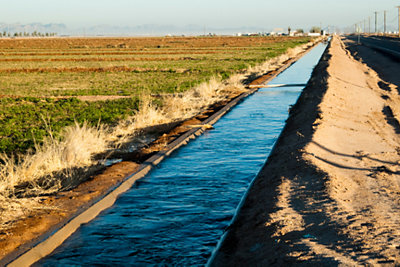How to Drain Your Irrigation System for Arizona’s Winter Season
Although Arizona is known for its sweltering and dry summers, winter months can be harsh and unforgiving, too. Did you know, in 1971, winter temperatures dropped to 40 degrees below zero, the coldest ever recorded in the state?
When Arizona's blistering summer heat starts to give way to cooler temperatures, properly draining your outdoor irrigation system may be your top priority. Arizona is different than most states when it comes to winter laws. Some people may be irrigating during the mild winter months, while others may be preparing to winterize their systems. If your area drops to freezing temperatures, neglecting this critical task could lead to cracked pipes or a damaged sprinkler. This could not only lead to expensive repairs but also make it harder to keep your lawn and garden healthy and lush come spring.
Read this guide to learn how to drain your irrigation system for winter.
Step-by-Step Guide on How to Drain Your Irrigation System for Winter
Now let's break down the complex Arizona winter lawn. If you're new to the desert, this may be your first-time hearing people water all winter long. During mild months, like November, many people may still be irrigating their lawns. In some cases, people have even prepped their yard for winter grass as early as October. This requires keeping the lawn damp for a few weeks, which means watering multiple times a day. Hold up, watering in the winter? Yes, you heard that right. But as colder temperatures take over, depending on your area, knowing how to winterize your sprinkler system may still be essential for safeguarding the system against winter damage. Here are the main steps involved:
1. Locate the Main Water Source
Start by finding the main shut-off valve to your irrigation system. It's usually located near your property line or close to the street. Once you find it, turn off the water. This simple action is your pipes' first line of defense against cold temperatures.
2. Drain the Water
Next, locate the drain valves situated along your irrigation system. These are your key tools for getting all the water out. Open them up and let the water flow out. This draining method works if you have manual valves.
A lawn sprinkler system with an automatic drain will automatically empty the water out of your pipes after each use.
Your residential water pressure should be set to 50 psi by default. This should drop to zero once you've successfully drained all the water from the irrigation system.
3. Use Air Compressors for Thorough Draining
In some cases, especially for more extensive irrigation systems, you might need an air compressor to blow out any excess water. This step ensures that no water is left to freeze and expand in your pipes.
If you're using an air compressor, connect it to the irrigation system and blow the water out zone by zone. Be careful not to use too much pressure, as the compressed air can damage the pipes.
4. Inspect and Drain the Backflow Device
Your backflow prevention device, which stops irrigation water from flowing back into your home's water supply, also needs attention. Drain it completely and check for any water that might be trapped inside. If there's any, gently remove it using the valves on the device.
5. Turn Off the Controller
Don't forget about your irrigation controller. While turning it off completely is an option, a better choice might be to switch it to the 'rain mode' or 'off season' setting if it has one. This way, your programming and timing settings will be saved for next season, but the system won't activate.
6. Insulate Exposed Parts
Finally, take a walk around and cover any exposed parts of your irrigation system, like valve boxes or above-ground pipes, with insulation materials. This step adds an extra layer of protection against the cold.
Draining and shutting off your residential irrigation system might seem a bit daunting at first. However, these straightforward steps will help you get it winter-ready in no time.
Seasonal Adjustments
As for your plants, their winter watering needs vary depending on the species and climate. Generally, most local landscaping plants don't require regular watering during the winter months. However, some exceptions exist. For example, winter-specific plants might need more frequent watering than their dormant summer cousins, especially if winter is unusually warm or dry.
When you do water, aim for the morning. This gives your plants time to absorb the water before it gets too cold in the evening.
Watering in the morning also helps prevent fungal growth, which can be a real party pooper for your plants. Avoid watering in the evening when temperatures are dropping. This can lead to ice formation on plant leaves and stems, causing potential damage.
Don't overwater your lawn and plants in the winter. Overwatering can lead to problems like root rot, pests, and fungal diseases. It's always better to err on the side of too little rather than too much.
Professional Assistance
While you might be tempted to tackle the winterizing process yourself, it's best to use a professional. Here's why:
They can catch those little issues that you might miss.
They know exactly how to shut off the water and drain every drop of water out of your system, protecting your pipes from damage.
They have the right tools, such as air compressors, and know-how to use them effectively.
They can save you time and effort.
They can help you avoid hefty spring repair bills.
They can provide customized care for your irrigation system.
Additionally, there's a comforting peace of mind that comes with knowing a pro has prepped your system for winter. You can snuggle up on cold nights knowing that your irrigation system is safely tucked away and ready to spring into action when the warmer weather returns.
Parker & Sons: Book an Appointment Today
At Parker & Sons, we offer a variety of services, including heating, air conditioning, plumbing, insulation, and electrical, to help you get ready for winter. We can provide these services separately or as part of a comprehensive winterization strategy for your Arizona home.
Parker & Sons is here to help with plumbing-related questions or issues inside or outside your home. Don't hesitate to get in touch with us now to schedule your appointment.
Related Reading
Subscribe to our e-Newsletter
Stay up-to-date on current news, promotions, and industry tips.

